Dave has been an energetic and enthusiastic member of NWSSA, and he currently serves as our Vice President. As we will learn, his broad training in art and his steady progress in sculpture has resulted in a well deserved blossoming of his career in the last few months.
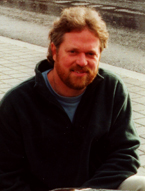
LE: Please introduce yourself--who are you?
DH: That’s a good opening question! My name is Dave Haslett. I work in stone, bronze, oil paint, and am a prolific drawer. I have owned my own business as a licensed general contractor since 1989, drawing plans and performing custom remodeling. Born and raised in the Pacific NW, I am the first male in a long line of loggers to not continue a career in the woods.
As a child at the age of two I discovered pencils and crayons. A simple 8” x 11” sheet of paper just would not do, but the entire bedroom walls and the stairwell did just fine until my parents discovered this amazing talent and took the pencils and crayons away for two years. Their next discovery was a drawing I did of a comic book cover (not traced), and the pencils, crayons and paper reappeared in abundance. My grandfather was editor of the Tacoma newspaper and would bring me large envelopes of paper. I lived to fill every sheet with a drawing or invention and that’s how it never stopped.
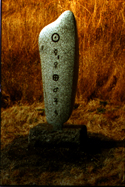
I grew up in the sixties and seventies, understanding an obvious energized change was taking place. Revolution. (musical interlude: anything by Jimi Hendrix for background.) Long hair, music, race riots, man on the moon, Kennedys and MLK assassinated, the Viet Nam war, all in full blown Technicolor.
LE: What were your educational experiences in art and sculpture?
DH: After two close draft calls, I enrolled into Portland State University, put myself through college, and made the Dean’s list. At the time, PSU had some of the best instructors in the NW, and this is where my first reawakening to becoming an artist happened. James Lee Hansen and Keith Jellum showed me the bronze foundry. Don Wilson introduced me to stone carving and educated us with stories and bag pipe music. Mel Katz badgered me into painting big, and there I painted some of my best work. The college art department had a magic atmosphere full of positive motivated students constantly producing and displaying their work. The scale that my instructors worked in was enormous and this had an influence on me. Not in the sense that bigger is better, but more the idea of the impact of the message working in a large-scale, and when do life experiences or situations present themselves, constituting these lines of thinking.
LE: Who were some of the artists that influenced you?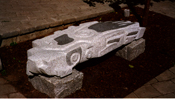
DH: Henry Moore, Salvador Dali, Alexander Calder, Pablo Picasso, and Hieronymus Bosch were big influences. Henry Moore’s bone series and his love for Mayan art, Dali painted dreams with childlike imagination, Calder applied orbital motion - the direct metaphor relating to the physical world, Picasso was Picasso laughing or crying, but always with large volumes of energy and Bosch was just on a roll with sin, fear and judgment.
LE: Why is art important to you?
DH: For me art represents the spirit that overcomes. The creative process is a powerful force about learning and seeing. Art teaches us how to use our eyes to really see, but it is not our eyes that are seeing. It is the brain’s ability to comprehend at another level, and once recorded, awakens the passion for the purpose of creating. Art is the foundation of humanity. It is hard to find anything around you in the everyday world that an artist has not had a hand in.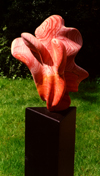
LE: How does your art reflect your philosophy?
DH: My philosophy. Well, it goes something like this: There are different forms of knowledge. “Instinctual knowledge” is the base level we use on a daily basis. “Particular knowledge” is of a vulnerable character and open to dispute. “Essential knowledge,” which is not the simple accumulation of factual or even conceptual information pertaining to objects or phenomena, consists of an awareness of the metaphysical through which the mind is able to gain its comprehension based on speculative or abstract reasoning. Observing nature fuels the imagination. An artist applying abstract reasoning uses will, memory, desire, curiosity, intuition, emotion, reason to serve the spirit in the search for expression or simply to understand the universal language of art.
LE: How has NWSSA influenced your work as an artist?
DH: NWSSA has opened doors that I never knew existed. The members are the hardest working support group any stone sculptor could hope to find. The sharing of information is priceless which has enabled me to understand the medium and expand my work to a grander scale. The influence of NWSSA continues in spirit when we are not together at symposia or workshops. This organization is a fantastic resource for learning carving, but also offers opportunities for members to get involved planning symposia, working on this valuable newsletter and participating in the annual events. The volunteer effort is the backbone of this organization, the energy we put in as a collective benefits us all. I look forward to discovering new directions through NWSSA and what the stones have to reveal.
LE: How do you get your ideas for your art?
DH: Reading books about Egypt is my #1 source for new ideas. #2 is reading a current Scientific American or Astronomy magazines. The articles get pretty thick, but I find analyzing the information, whether I get it or not, forces me to think in non-linear terms. This in turn sparks new direction. #3 The book Sacred Geometry covers universal order and the fundamental nature of matter. It is written and illustrated in a very understandable format and is a good one for artists.
LE: Describe the transformative experience in your art.
DH: Of course, there is the preliminary evaluation and plan of attack, but then it’s a matter of seeing what you really have before you and diving in. As the layers of stone fall away, patterns begin to reveal themselves, then the proportion of forms, working together or not, combined with the color in the stone suggests a direction. These inevitable changes alter any preconceptions. This is the part I really enjoy. The stone reveals a sense of its geometry and that’s when carving just happens.
LE: How do you develop your ideas?
DH: I like to create in both styles: direct carving and preplanning. Direct carving is the most relaxed and exciting way to bond with the stone and see what happens. Most of the time the results are very rewarding. Preplanning is more structured and begins with lots of drawings. I love to draw and see how ideas evolve. The drawings eventually get to the crystal clear stage and then it’s time to carve. I have learned to listen, though, when the stone has something to say about crystal clear. This dialog begins during carving and turns into a little dance. Lots of drawing on the stone and pondering, especially right at dusk. The low light is a great tool to see form. I get to the “mutual agreement” stage, content knowing the material just a little bit better.
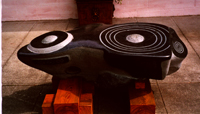
LE: Describe a recent piece or two.
DH: I’m using two stones, one twice the size of the other, and both standing vertically. There are two thin vertical slices 80% through the middle of each stone. The stones are aligned so that when the sun passes through the large stone it eclipses the smaller stone in its shadow, the light passes through the smaller stone slices and creates a continuous strip of light through the shadow. I call them Solstice Stones.
LE: What do you like about them?
DH: They were born on the day of our most recent lunar eclipse, in June of this year. They are small maquettes now, but have the potential to be very large.
LE: Do you work part time or full time as an artist?
DH: It’s about 50% art and 50% contracting. When I’m contracting I think about carving. Being away from the actual physical process of making art, you can still be mentally involved. It’s part of creating and keeps the project fresh and objective—plus it builds anticipation. When I return to the studio, I get more done in a shorter period of time.
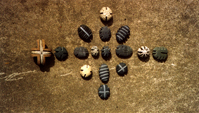
LE: What stones do you prefer?
DH: Granite seems to be my stone of choice right now. I think about the immense pressures, heat and force that made this quartz, mica mix into granite and it just radiates compressed energy. A beautiful material. I was introduced to Rainforest Marble by Randy Zieber several years ago, and that is my other favorite stone of choice.
LE: Do you work on one piece at a time or are several inthe process at once?
DH: Usually I will work on two or three pieces at a time. The reason is if I lose my “vision” of where one piece is going, but have not lost my carving energy, I can keep the creative flow moving. This way I can feed off of the different forms using the same tools at each step.
LE: What tools do you use?
DH: Skil saw with a 7” diamond blade wet, angle grinders with 4” diamond cup wheels and 4” blades wet, silicon carbide grinding disks dry, Trow & Holden 1” D and 3/4” B air hammers, Zec wheels, resin diamond polishing disks wet, hand tools, flat bars, and magic dust.
LE: Where do you exhibit your art?
DH: Currently I have work in the Belinky DuPree Gallery, Portland, Oregon, the Artists in Residence Gallery, Eastsound, Washington, and the Gail Severn Gallery, Ketchum, Idaho, as well as in sculpture parks in Eastsound Washington, Roche Harbor, Washington, Lake Oswego, Oregon, and Ketchum, Idaho.
LE: How did you arrive in the Sun Valley gallery?
DH: Gail Severn called me this spring and said she had seen my work in the Portland gallery and wanted to know if I would consider showing work in her gallery in Idaho. She was interested in my moderately priced work. I asked her what kind of gallery she had and she said it was like her gallery in Portland--very upper end. She also has a two-acre sculpture garden, and they were celebrating their 25th year as a gallery this summer. Photos via email revealed how beautiful this gallery is. Ironically, while I was firming up a delivery date, friends of ours offered their house in Ketchum, as they felt Jan and I needed to visit and get acquainted with the art scene. I said, “How about next week?” They looked surprised, so I told them what was going on with Gail, then they got really excited. There are some amazing artists represented there and I am truly blessed to be invited to this gallery. I delivered 15 moderately priced pieces July 3, 2002, and met Gail Severn and her very efficient staff. All but two pieces sold in 10 days. I’ve just delivered two higher end pieces, so we will see. I’m still kind of in shock.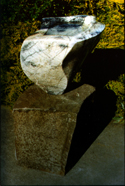
LE: How much work do you complete in a year?
DH: Three years ago I produced six sculptures, last year 13, and so far this year I’m at 14. At this pace it could be a record for me.
LE: What scale or size you work in?
DH: The majority of my work is in the 150- 400 pound range. That is a nice manageable size for me. “Arc of Intentional Influence” started at 3000 pounds and finished at 1550 pounds, one of my granite benches weighs 1200 pounds finished, and the bench I started at Camp Brotherhood weighs 650 pounds finished.
LE: Do you have a favorite scale?
DH: I’m finding myself pondering large stones, but I don’t think there is a favorite. Stones you can hold in your hand are quite nice and offer a lot of information. Generally my response is to the stone and what might be lurking inside.
LE: How is your work area set up?
DH: I use a tripod with a chain hoist over my large stone area. It enables me to lift, roll, load, and unload up to 3000 pound stones by myself. For the smaller stones, I have several heavy duty work tables set up and lots of beams for dunnage. I have a 5-HP, 2-stage air compressor with an 80 gallon tank and 250’ of air hose, the heart and lungs of the studio.
LE: What have been your satisfactions in your life as an artist?
DH: The vitality that art continually brings into my life. I enjoy producing, learning, and exploring. Viewing other artists work, meeting other artists, traveling and seeing masterworks. The idea that I’m a link in an ongoing chain of creative individuals is quite satisfying. I don’t know how it would be possible for me to go through life without making art.
LE: What are you looking forward to?
DH: Sales! Lots of sales and commissions. I have so many ideas-my goal is to get into a full time art production mode. It’s time to really push my work to another level. One idea I have that would involve lots of sculptors is to arrange large stones into an alignment or large circular arrangement or both. It would be a dynamic group exercise. I’ll keep you posted.
Finally, I just want to say thank you, Larry and NWSSA, for giving me this opportunity to express a little part of my world. I have to admit doing this interview has made me remember things I have not thought about in some time. It has been a good exercise reviewing where inspiration comes from. Art is important. I feel artists are at the bow of the ship of life, they are the visionaries to the natural world using intellectual powers to really see and, on occasion, advance our own evolution. Art reflects into society and gets digested, processed, evaluated, even criticized. Sometimes movements are born. What’s left behind in the wake are the moments captured in stone, bronze, paint, pastel, photography, pencil; whatever justifies documentation becomes art. Keep producing as much as you can, when you don’t feel like creating, try it anyway, those moments can reveal some very interesting new directions. Carve proud NWSSA!
